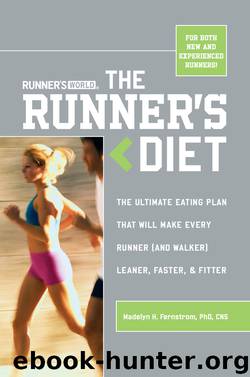Runner's World The Runner's Diet by Madelyn Fernstrom

Author:Madelyn Fernstrom
Language: eng
Format: epub
Publisher: Rodale
Published: 2005-12-15T16:00:00+00:00
THE RUNNING HOW-TO LIST: THE TOOLS YOU NEED FOR EXERCISE
When it comes to choosing gear for running and walking, it is pretty simple. All you need is some good shoes. But the locker you keep in your mind needs a few more items in it—the tools you’ll use to track your progress and overcome obstacles. Below are the important measurements and issues you’ll be dealing with as you incorporate more activity into your weight-loss program.
HOW TO TELL THE DIFFERENCE BETWEEN MENTAL FATIGUE AND PHYSICAL FATIGUE
If exercising were easy, we’d be a country of people who looked more like carrots and less like apples. Unfortunately, real life intervenes, and everything from deadlines and schedules to family and illness gets us off track. One of the most common reasons I hear for not getting into a walking or running routine (or having a routine get derailed) is “I’m too tired to exercise.”
The first step in facing this challenge is to distinguish between mental and physical fatigue. As I’ll describe below, a regularly worn pedometer is the best tool to measure whether your fatigue is physiological (you really are active) or psychological (mental stress is tiring!). Some of the biggest surprises can come from wearing a pedometer for a day and comparing your sense of fatigue and the number of steps you take. Consider Alison, who felt she had an enormous amount of exercise in her daily activity as a representative of a prescription drug company. Alison enjoyed recreational running, but she always felt exhausted at the end of the day of visiting multiple doctors’ offices and presenting her products. She complained of being too tired to do more. When Alison wore a pedometer, she was surprised to see she was walking between 5,000 and 6,500 steps per day. When we evaluated her activity, she acknowledged that she parked as close as she could and did very little walking other than to and from her car (lugging her products in a rolling cart). Her tiredness, she agreed, came from the mental exhaustion of selling with her sales tied to her income. When Alison saw the evidence that she was not particularly active, she agreed to boost her activity to 8,000 to 10,000 steps a day in the first 2 weeks of change, and to stay at more than 10,000 steps in the 2 weeks after that.
Within 1 month, Alison almost doubled her steps through a combination of daily activity and weekend running—which turned out to be a great stress reliever. During her workweek, Alison increased her steps to about 7,500 steps a day (an additional mile). She also ran on the treadmill to reach 10,000 steps, adding another mile and an additional 15 minutes of exercise to her day. By including running or walking as a stress reliever, Alison took a positive step toward a sense of well-being and fitness. The bonus was that Alison also found it much easier to maintain her current weight. “I always felt under so much pressure to monitor my eating,” she said.
Download
This site does not store any files on its server. We only index and link to content provided by other sites. Please contact the content providers to delete copyright contents if any and email us, we'll remove relevant links or contents immediately.
How to Be a Bawse: A Guide to Conquering Life by Lilly Singh(7382)
Deep Work by Cal Newport(6873)
The Longevity Diet by Valter Longo(5017)
The Fat Loss Plan by Joe Wicks(4845)
The Four-Pack Revolution by Chael Sonnen & Ryan Parsons(3932)
The Ultimate Bodybuilding Cookbook by Kendall Lou Schmidt(3884)
The French Women Don't Get Fat Cookbook by Mireille Guiliano(3604)
Super Food Family Classics by Jamie Oliver(3366)
Not a Diet Book by James Smith(3335)
Factfulness_Ten Reasons We're Wrong About the World_and Why Things Are Better Than You Think by Hans Rosling(3197)
Turn Up Your Fat Burn! by Alyssa Shaffer(3182)
Self-Esteem by Matthew McKay & Patrick Fanning(3091)
Tom Kerridge's Dopamine Diet: My low-carb, stay-happy way to lose weight by Kerridge Tom(3063)
Body Love by Kelly LeVeque(3012)
The Unbecoming of Mara Dyer by Michelle Hodkin(2998)
The Fat Chance Cookbook by Robert H. Lustig(2791)
Tone Your Tummy Type by Denise Austin(2785)
LL Cool J's Platinum 360 Diet and Lifestyle by LL Cool J(2685)
Men's Health Best by Men's Health Magazine(2551)
